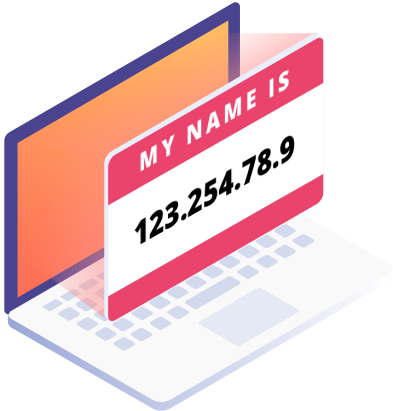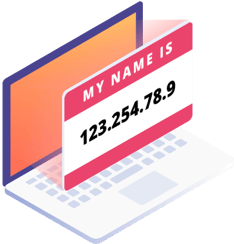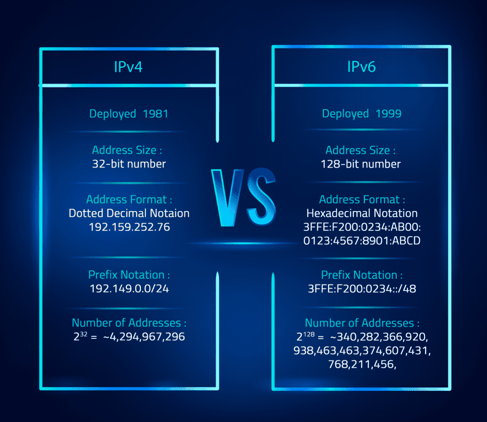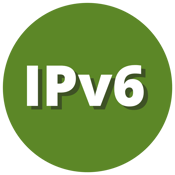How to Transition from IPv4 to IPv6: Things You Should Consider

IPv4 address exhaustion is an issue that runs deep into every part of the service provider’s business and is no longer a topic that one can forego action on. There are two main options service providers have today.
 Continue buying IPv4 addresses at market.
Continue buying IPv4 addresses at market.- Leverage CGNAT to use IPv6 addresses while maintaining IPv4 usability.
IPv4 address exhaustion is not a new phenomenon but it is a topic that can no longer be put off. Figuring out how to best leverage either option can seem like a daunting and unapproachable undertaking from the outside looking in.
But, as a full service solution provider, our team at CCI has helped providers and operators create and execute plans for a successful migration to IPv6 or joint usage of IPv4 and IPv6.
By the end of this article, you'll learn the exact difference between IPv4 and IPv6, what some considerations you should take into account concerning cost and technical requirements are, and the next steps to crafting your plan for future success.
Let’s get started!
What is an IP Address?
An IP address is a unique numerical identifier for every device that is connected to a network and can be thought of most simply as a destination for communication. IP addresses serve to standardize how devices connect and how the information they share is passed back and forth.
This information is transmitted in the form of “packets” or small amounts of data that are vital to loading things like webpages, emails, videos, and more. Since 1981 there has been one main form of IP address; IPv4. While these addresses served their purpose for many years, the supply of IPv4 addresses is running out which has sent operators looking for an answer.
Launched in 1999, IPv6 addresses are increasingly becoming that answer. Let’s take a look at what exactly each of these IP addresses might mean to you as an operator.
What is IPv4?
Tried and true, IPv4 addresses are the fourth version of the Internet Protocol and have been what the Internet has leaned on since 1981. Every device that we use and connect to day to day has an IP address, but what is the technology behind them and why have we run out of them?

In an effort to not get too technical, the technology behind IPv4 addresses can most simply be understood as using 32-bit addresses for Internet addresses. This means that IPv4 can support 2^32 IP addresses which comes out to roughly 4.3 billion addresses.
This number may seem enormous, but it is not nearly enough to service all the devices that are now connected around the globe.
Easily available IPv4 address blocks were depleted from the American Registry for Internet Numbers (ARIN) in September of 2015. The global pool where ARIN got their addresses—managed by the Internet Assigned Numbers Authority (IANA)—was depleted in 2011.
What is IPv6?
IPv6, or Internet Protocol Version 6, is the latest version of Internet Protocol that will be used to accomplish the same tasks that IPv4 has for so long. Those tasks being carrying data packets to and from different communication destinations.
Some things have changed though when looking at IPv6 compared to IPv4 addresses like the address size, address format, prefix notation, and a staggering difference in the overall number of available addresses.
The sheer number of available IPv6 addresses is one major driving factor for operators to begin to adopt this protocol if they haven’t already.
No longer would groups of machines have to operate off of a shared IPv4 address that requires a NAT (Network Address Translation) which is followed by complex configurations to access a certain machine.
With IPv6, every machine would have its very own address, simplifying the data communication problem that is found with IPv4 address scarcity.
IPv4 or IPv6: What Are My Options?
Attaining and managing IP address space for network operators is not as straightforward as it used to be. The cost of IPv4 space at auction keeps going up, but IPv6 adoption has gained a lot of momentum, and there will be a tipping point where IPv4 address value will drop off.
Buying an allocation of IPv4 addresses feels a lot like playing the market. Depending on the volume of addresses needed, some operators see IPv4 addresses as an operational cost of doing business. Large volumes of addresses simply are not available, making IPv6 the only path to take for large deployments.
There are IPv4-only services and resources on the Internet, so a good IPv6 to IPv4 Network Address Translation (NAT) strategy is needed. For most of us in the middle, there are decisions to make.
Decision Factors for IPv4 and IPv6: Cost

Cost of IPv4 Allocations
IPv4 addresses are running for about $40 each (~$10k per /24) at auction right now.
If you only need a couple /24s for the long-term, this will work until there are IPv6-only services on the Internet that your customers need.
Cost of IPv6 Solution
There are lots of factors and variables here that affect the cost to implement an IPv6 solution, otherwise known as CGNAT. Let’s say you need to support around 80Gbps of traffic that needs to be IPv4-IPv6 translated.

A ballpark estimate for the equipment would be $50,000 for a single-threaded solution, or $100,000 for a fully redundant solution. The good news here is that the right platform can support multiple NAT solutions, making it useful after IPv6 adoption hits critical mass and your network is primarily IPv6.
The cost point at which CGNAT makes sense to deploy is lower than many operators think. An 80Gbps solution is to support the traffic that needs to be translated, NOT all Internet traffic for the operator. Much of the IPv6 traffic will stay IPv6 on the Internet and not need translating.
Technical Requirements of IPv4 and IPv6
Making sure that you have all of the technical capabilities to deploy and support IPv6 and CGNAT will be vital to the successful completion of any level IPv6 implementation.
IPv6 requires specific technology implementations such as DHCP, DNS, and routing protocols to support it. The good news is that IPv4 and IPv6 can run natively on the same network at the same time. This gives operators time to get used to the new protocols and address space.
The Future of IPv4 and IPv6 As We See It
Picking up IPv4 at auction is just a temporary fix and shouldn’t be recognized as a viable long-term solution. IPv6 adoption is picking up momentum, and soon there will be services on the Internet that only function with IPv6.
Now “soon” is a relative term when it comes to IPv6 adoption, but the charts are starting to point almost straight up, and Google has estimated that 35% of clients worldwide currently have IPv6 enabled.

The right CGNAT infrastructure will position operators to expand their network with IPv6, migrate some IPv4 connections and customers to IPv6 to free up IPv4, and will provide years of functionality.
One strategy that we’ve seen operators use is selling their excess IPv4 space to pay for network augments and expansion. The end game for the CGNAT gear is to translate the IPv6 native traffic on the operator network to IPv4-only services on the Internet, which will scale down over time.
Moving forward we do not see that as a system that will grow in capacity with your upstream Internet connections. Many large IPv6-only operator networks are running that utilize CGNAT at the edge for IPv4-only resources.
At the very least, operators should be deploying IPv6 along with IPv4 (dual-stack) on their network to get used to the addressing, protocols, and tools associated with where IP addressing is going.
Ready to Address Your IP Address Problems?
As a solution provider, CCI helps operators with a wide variety of updates, migrations, and protocol changes, including IPv4 exhaustion and the transition to IPv6. Our experts have helped several operators construct and execute plans on how to best manage their IP address problems, as we all move into the future of connectivity and the requirements it brings.
If you're unsure about the best way to tackle your IP strategy, discuss your options moving forward with an expert and learn what impact those options could have on your network and your subscribers.
Want to learn more about IP addressing? Learn how you can monetize your IPv4 addresses before IPv6 becomes in the standard.

